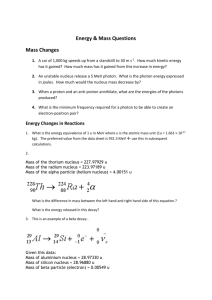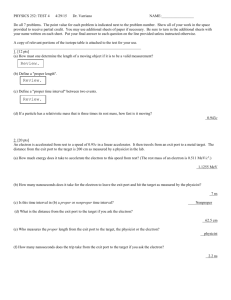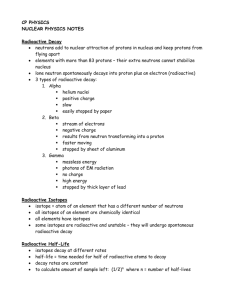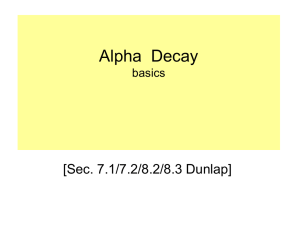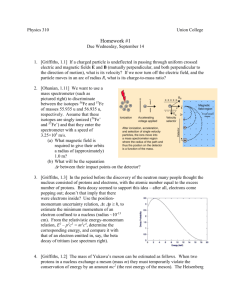atoms and nuclei
advertisement
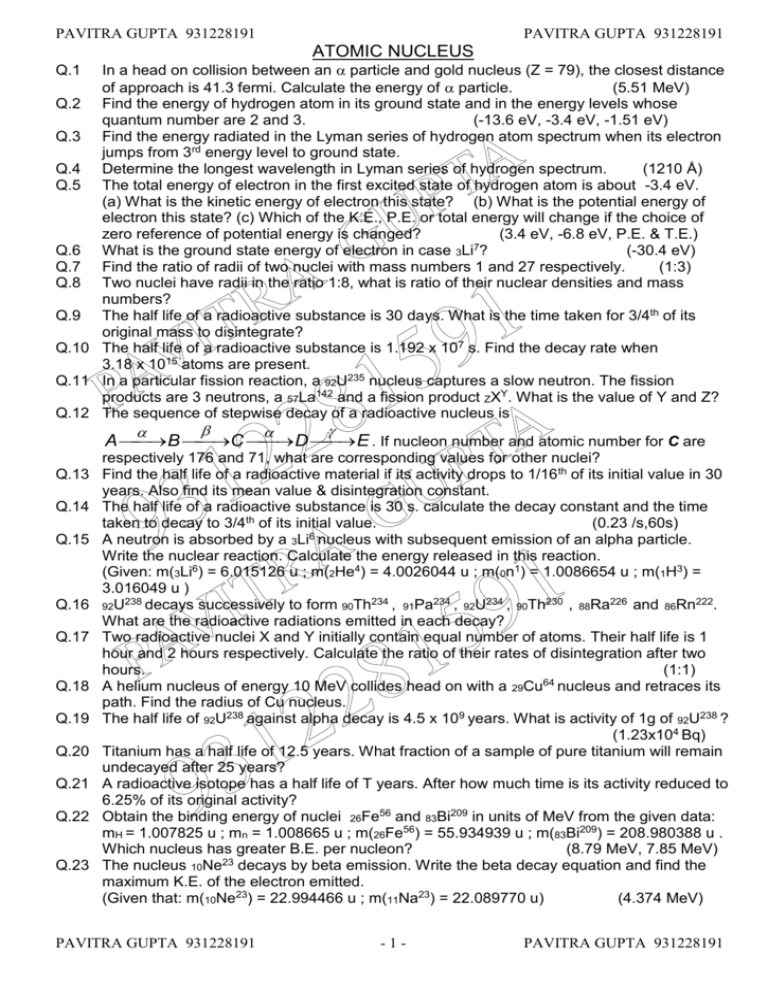
PAVITRA GUPTA 931228191 PAVITRA GUPTA 931228191 ATOMIC NUCLEUS In a head on collision between an particle and gold nucleus (Z = 79), the closest distance of approach is 41.3 fermi. Calculate the energy of particle. (5.51 MeV) Q.2 Find the energy of hydrogen atom in its ground state and in the energy levels whose quantum number are 2 and 3. (-13.6 eV, -3.4 eV, -1.51 eV) Q.3 Find the energy radiated in the Lyman series of hydrogen atom spectrum when its electron jumps from 3rd energy level to ground state. Q.4 Determine the longest wavelength in Lyman series of hydrogen spectrum. (1210 Å) Q.5 The total energy of electron in the first excited state of hydrogen atom is about -3.4 eV. (a) What is the kinetic energy of electron this state? (b) What is the potential energy of electron this state? (c) Which of the K.E., P.E. or total energy will change if the choice of zero reference of potential energy is changed? (3.4 eV, -6.8 eV, P.E. & T.E.) 7 Q.6 What is the ground state energy of electron in case 3Li ? (-30.4 eV) Q.7 Find the ratio of radii of two nuclei with mass numbers 1 and 27 respectively. (1:3) Q.8 Two nuclei have radii in the ratio 1:8, what is ratio of their nuclear densities and mass numbers? Q.9 The half life of a radioactive substance is 30 days. What is the time taken for 3/4th of its original mass to disintegrate? Q.10 The half life of a radioactive substance is 1.192 x 107 s. Find the decay rate when 3.18 x 1015 atoms are present. Q.11 In a particular fission reaction, a 92U235 nucleus captures a slow neutron. The fission products are 3 neutrons, a 57La142 and a fission product ZXY. What is the value of Y and Z? Q.12 The sequence of stepwise decay of a radioactive nucleus is Q.1 A B C D E . If nucleon number and atomic number for C are Q.13 Q.14 Q.15 Q.16 Q.17 Q.18 Q.19 Q.20 Q.21 Q.22 Q.23 respectively 176 and 71, what are corresponding values for other nuclei? Find the half life of a radioactive material if its activity drops to 1/16 th of its initial value in 30 years. Also find its mean value & disintegration constant. The half life of a radioactive substance is 30 s. calculate the decay constant and the time taken to decay to 3/4th of its initial value. (0.23 /s,60s) 6 A neutron is absorbed by a 3Li nucleus with subsequent emission of an alpha particle. Write the nuclear reaction. Calculate the energy released in this reaction. (Given: m(3Li6) = 6.015126 u ; m(2He4) = 4.0026044 u ; m(0n1) = 1.0086654 u ; m(1H3) = 3.016049 u ) 238 decays successively to form 234 , 234 , 234 , 230 , 226 and 222. 92U 90Th 91Pa 92U 90Th 88Ra 86Rn What are the radioactive radiations emitted in each decay? Two radioactive nuclei X and Y initially contain equal number of atoms. Their half life is 1 hour and 2 hours respectively. Calculate the ratio of their rates of disintegration after two hours. (1:1) 64 A helium nucleus of energy 10 MeV collides head on with a 29Cu nucleus and retraces its path. Find the radius of Cu nucleus. The half life of 92U238 against alpha decay is 4.5 x 109 years. What is activity of 1g of 92U238 ? (1.23x104 Bq) Titanium has a half life of 12.5 years. What fraction of a sample of pure titanium will remain undecayed after 25 years? A radioactive isotope has a half life of T years. After how much time is its activity reduced to 6.25% of its original activity? Obtain the binding energy of nuclei 26Fe56 and 83Bi209 in units of MeV from the given data: mH = 1.007825 u ; mn = 1.008665 u ; m(26Fe56) = 55.934939 u ; m(83Bi209) = 208.980388 u . Which nucleus has greater B.E. per nucleon? (8.79 MeV, 7.85 MeV) 23 The nucleus 10Ne decays by beta emission. Write the beta decay equation and find the maximum K.E. of the electron emitted. (Given that: m(10Ne23) = 22.994466 u ; m(11Na23) = 22.089770 u) (4.374 MeV) PAVITRA GUPTA 931228191 -1- PAVITRA GUPTA 931228191 PAVITRA GUPTA 931228191 PAVITRA GUPTA 931228191 Q.24 The average energy released per fission of 94Pu239 is 180 MeV. How much energy will release if all the atoms in 1 kg of pure 94Pu239 undergo fission? (4.5 x 1023 MeV) Q.25 Which one of the energy level transition will result in the emission of photon of wavelength 0 eV 620 nm? A - 1 eV B D E - 3 eV C - 10 eV Q.26 Obtain the maximum K.E. of beta particles and radiation frequencies to gamma decays in the following decay scheme. Given that: m(198Au) = 197.968233 u and m(198Hg) = 197.96676. 198 Au 1 1.0 8 8 MeV 2 1 3 0.412 MeV 2 0 MeV 198 Q.27 Q.28 Q.29 Q.30 Q.31 Q.32 Q.33 Q.34 Q.35 Q.36 Q.37 Q.38 Q.39 Q.40 Q.41 Q.42 Q.43 Hg Why is the energy distribution of beta rays continuous during - decay of a nucleus? Name the reaction responsible for energy production in the sun. Define decay constant of a radioactive element. You are given 2 nuclei 3X7 and 3Y4. Which one of them is likely to be more stable? Why? Draw the graph showing the variation of B.E. per nucleon with mass number of different nuclei. State 2 inferences form the graph. Among , and which of the radiations: (a) are similar to X – rays? (b) are easily absorbed by matter? (c) travel with greatest speed? (d) are similar to the cathode rays? Out of 14X30 , 3Y6 and 40Z130, which is more likely to undergo nuclear fission? What is the significance of negative energy of electron in an orbit? What is the value of P.E. of an electron when it is far away from the nucleus? A nucleus contains no electrons, yet it ejects them during - decay. How? What are nuclear forces? Give 4 important properties of them. What do you mean by excitation potential and ionization potential? What is the ionization potential of hydrogen atom? Name the series of hydrogen spectrum lying in the (i) UV region (ii) infrared region (iii) visible region. Is free neutron a stable particle? Explain. What holds nucleons together in a nucleus? Define B.E. of a nucleus. What do mean by the fact that the B.E. of He nucleus is 28.17 MeV? What is the cause of production of large amount of energy in nuclear reaction? PAVITRA GUPTA 931228191 -2- PAVITRA GUPTA 931228191
